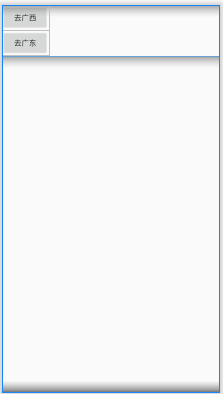詳解Android studio 動(dòng)態(tài)fragment的用法
fragment的使用時(shí)Android的基礎(chǔ),它有兩種用法,第一個(gè)就是靜態(tài)的fragment。第二個(gè)則是動(dòng)態(tài)的fragment。靜態(tài)fragment直接在layout創(chuàng)建你想要的fragment的XML的文件,然后在你的Java包里面創(chuàng)建對(duì)應(yīng)fragment的class文件布局代碼如下所示

<?xml version='1.0' encoding='utf-8'?><LinearLayout xmlns:android='http://schemas.android.com/apk/res/android' android:layout_width='match_parent' android:layout_height='match_parent' android:orientation='vertical'> <TextView android:layout_width='match_parent' android:layout_height='wrap_content' android:text='歡迎來(lái)到廣西!'/></LinearLayout>

<?xml version='1.0' encoding='utf-8'?><LinearLayout xmlns:android='http://schemas.android.com/apk/res/android' xmlns:app='http://schemas.android.com/apk/res-auto' xmlns:tools='http://schemas.android.com/tools' android:layout_width='match_parent' android:layout_height='match_parent' android:orientation='vertical' tools:context='.MainActivity'> <Button android:layout_width='wrap_content' android:layout_height='wrap_content' android:text='去廣西' android: /> <Button android:layout_width='wrap_content' android:layout_height='wrap_content' android:text='去廣東' android: /> <LinearLayout android:layout_width='match_parent' android:layout_height='wrap_content' android:orientation='vertical' android: android:layout_weight='9'> </LinearLayout> <fragment android:layout_width='wrap_content' android:layout_height='wrap_content' android: /></LinearLayout>
*這里需要注意一下,如果你不給fragment加個(gè)id,那你運(yùn)行app的時(shí)候?qū)?huì)發(fā)生閃退現(xiàn)象。

package com.example.anyone_fragment_2;import android.os.Bundle;import android.view.LayoutInflater;import android.view.View;import android.view.ViewGroup;import android.widget.Button;import androidx.annotation.NonNull;import androidx.annotation.Nullable;import androidx.fragment.app.Fragment;public class Fragment_1 extends Fragment { @Nullable @Override public View onCreateView(@NonNull LayoutInflater inflater, @Nullable ViewGroup container, @Nullable Bundle savedInstanceState) { View view=inflater.inflate(R.layout.fragment_1,container,false); return view; }}
這樣靜態(tài)fragment算是弄好了,但是這次我們主要討論動(dòng)態(tài)fragment的用法
首先,我們先在activity_main中寫(xiě)下如下代碼
<?xml version='1.0' encoding='utf-8'?><LinearLayout xmlns:android='http://schemas.android.com/apk/res/android' xmlns:app='http://schemas.android.com/apk/res-auto' xmlns:tools='http://schemas.android.com/tools' android:layout_width='match_parent' android:layout_height='match_parent' android:orientation='vertical' tools:context='.MainActivity'> <Button android:layout_width='wrap_content' android:layout_height='wrap_content' android:text='去廣西' android: /> <Button android:layout_width='wrap_content' android:layout_height='wrap_content' android:text='去廣東' android: /> <LinearLayout android:layout_width='match_parent' android:layout_height='wrap_content' android:orientation='vertical' android: android:layout_weight='9'> </LinearLayout></LinearLayout>
布局效果圖是這樣的

這里fragment的XML文件和開(kāi)頭所說(shuō)的靜態(tài)fragment的那個(gè)XML文件的寫(xiě)法是一樣的同理,fragment對(duì)應(yīng)的class文件也是相同的。
package com.example.anyone_fragment_2;import androidx.appcompat.app.AppCompatActivity;import androidx.fragment.app.Fragment;import androidx.fragment.app.FragmentManager;import androidx.fragment.app.FragmentTransaction;import android.os.Bundle;import android.view.View;import android.widget.Button;public class MainActivity extends AppCompatActivity implements View.OnClickListener {//有abstract就閃退 private Button bt_anjian1,bt_anjian2; private Fragment Fragment_1,Fragmentnow,Fragment_2; private FragmentManager fragmentManager; private FragmentTransaction fragmentTransaction; @Override protected void onCreate(Bundle savedInstanceState) { super.onCreate(savedInstanceState); setContentView(R.layout.activity_main); chushihua(); shilihua(); } private void chushihua() { bt_anjian1=findViewById(R.id.bt_anjian1); bt_anjian2=findViewById(R.id.bt_anjian2); bt_anjian1.setOnClickListener(this); bt_anjian2.setOnClickListener(this); } private void shilihua(){ //用于實(shí)例化fragment Fragment_1=new Fragment_1(); Fragment_2=new Fragment_2(); Fragmentnow=Fragment_1; fragmentManager=getSupportFragmentManager(); fragmentTransaction=fragmentManager.beginTransaction(); //38:只要你要對(duì)fragment進(jìn)行操作就少不了這句 原來(lái)的寫(xiě)法是FragmentTransaction fragmentTransaction=fragmentManager.beginTransaction(); fragmentTransaction.add(R.id.ll_rongqi,Fragment_1).commit(); } public void onClick(View vv) { fragmentTransaction=fragmentManager.beginTransaction(); switch (vv.getId()) { case R.id.bt_anjian1:if (Fragment_1.isAdded()) { fragmentTransaction.hide(Fragmentnow).show(Fragment_1).commit(); } else { fragmentTransaction.hide(Fragmentnow).add(R.id.ll_rongqi,Fragment_1).commit(); } Fragmentnow=Fragment_1; break; case R.id.bt_anjian2:if(Fragment_2.isAdded()) { fragmentTransaction.hide(Fragmentnow).show(Fragment_2).commit(); } else { fragmentTransaction.hide(Fragmentnow).add(R.id.ll_rongqi,Fragment_2).commit(); } Fragmentnow=Fragment_2; break; } }}
下面來(lái)分析一些地方初始化功能函數(shù)
private void chushihua() { bt_anjian1=findViewById(R.id.bt_anjian1); bt_anjian2=findViewById(R.id.bt_anjian2); bt_anjian1.setOnClickListener(this); bt_anjian2.setOnClickListener(this); }
這樣寫(xiě)的目的是讓代碼可讀性更好,不至于很混亂。
其次就是實(shí)例化我們所寫(xiě)的fragment功能函數(shù)
private void shilihua(){ //用于實(shí)例化fragment Fragment_1=new Fragment_1(); Fragment_2=new Fragment_2(); Fragmentnow=Fragment_1; fragmentManager=getSupportFragmentManager(); fragmentTransaction=fragmentManager.beginTransaction(); //38:只要你要對(duì)fragment進(jìn)行操作就少不了這句 原來(lái)的寫(xiě)法是FragmentTransaction fragmentTransaction=fragmentManager.beginTransaction(); fragmentTransaction.add(R.id.ll_rongqi,Fragment_1).commit(); }
其中的
FragmentManager fragmentManager;
這個(gè)是fragment和activity交互所要用到的。
fragmentManager=getSupportFragmentManager();
固定寫(xiě)法。
而
private FragmentTransaction fragmentTransaction; fragmentTransaction=fragmentManager.beginTransaction();
是調(diào)動(dòng)fragment操作的API,也必不可少。
fragmentTransaction.add(R.id.ll_rongqi,Fragment_1).commit();
是添加fragment所用的語(yǔ)句,在這里就相當(dāng)于是初始化吧。add(容器id,碎片對(duì)象),commit則是提交。
public void onClick(View vv) { fragmentTransaction=fragmentManager.beginTransaction(); switch (vv.getId()) { case R.id.bt_anjian1:if (Fragment_1.isAdded()) { fragmentTransaction.hide(Fragmentnow).show(Fragment_1).commit(); } else { fragmentTransaction.hide(Fragmentnow).add(R.id.ll_rongqi,Fragment_1).commit(); } Fragmentnow=Fragment_1; break; case R.id.bt_anjian2:if(Fragment_2.isAdded()) { fragmentTransaction.hide(Fragmentnow).show(Fragment_2).commit(); } else { fragmentTransaction.hide(Fragmentnow).add(R.id.ll_rongqi,Fragment_2).commit(); } Fragmentnow=Fragment_2; break; } }
這里的onClick的名字是不能改變的,否則你button沒(méi)辦法觸發(fā)。用傳來(lái)的形參View vv來(lái)獲取到我們所點(diǎn)擊的按鈕來(lái)判斷操作。思想就是,如果Fragment存在,則只需要把它展示出來(lái)即可。isAdded嘛,ed過(guò)去式,那就是代表存在過(guò)咯。若是沒(méi)有,則添加就好。
好了,就到這吧,有錯(cuò)誤的話(huà)希望能指出來(lái),大家一起共同進(jìn)步!
到此這篇關(guān)于詳解Android studio 動(dòng)態(tài)fragment的用法的文章就介紹到這了,更多相關(guān)Android studio fragment用法內(nèi)容請(qǐng)搜索好吧啦網(wǎng)以前的文章或繼續(xù)瀏覽下面的相關(guān)文章希望大家以后多多支持好吧啦網(wǎng)!
相關(guān)文章:
1. python爬蟲(chóng)實(shí)戰(zhàn)之制作屬于自己的一個(gè)IP代理模塊2. IntelliJ IDEA刪除類(lèi)的方法步驟3. HTML 絕對(duì)路徑與相對(duì)路徑概念詳細(xì)4. python實(shí)現(xiàn)PolynomialFeatures多項(xiàng)式的方法5. Spring如何使用xml創(chuàng)建bean對(duì)象6. python 利用toapi庫(kù)自動(dòng)生成api7. python實(shí)現(xiàn)在內(nèi)存中讀寫(xiě)str和二進(jìn)制數(shù)據(jù)代碼8. IntelliJ IDEA設(shè)置默認(rèn)瀏覽器的方法9. Java程序的編碼規(guī)范(6)10. Android Studio設(shè)置顏色拾色器工具Color Picker教程

 網(wǎng)公網(wǎng)安備
網(wǎng)公網(wǎng)安備